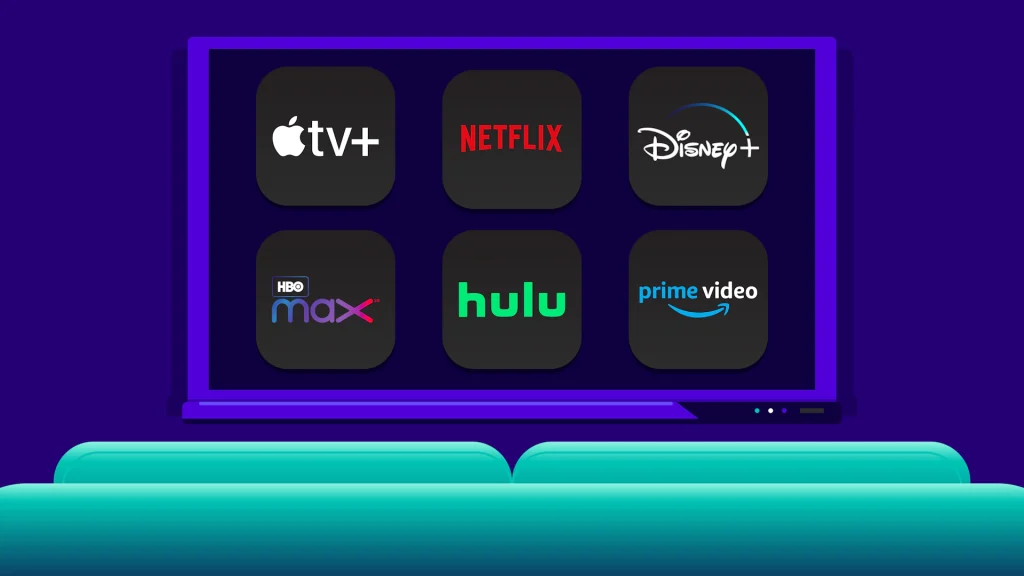The media and entertainment sectors have undergone a revolution thanks to the development of streaming services, which have changed how we engage with and consume media. From the early days of digital streaming to the advanced platforms of today, this change has altered content production, industry economics, and viewing habits. This article examines the development of streaming services, emphasizing significant turning points and contemporary patterns that will influence the future.

The Early Days of Digital Streaming
Although the idea of streaming has existed since the 1990s, it didn’t start to become popular until the early 2000s. In 1995, RealNetworks introduced RealPlayer, the first significant digital streaming service that enabled users to stream video and audio content online. However, during these early years, streaming’s growth was limited by bandwidth restrictions and the high cost of internet access.
The Rise of Subscription-Based Models
Subscription-based streaming models, which would later become the industry’s mainstay, first appeared in the early 2000s. Originally established in 1997 as a DVD rental service, Netflix switched to streaming in 2007. Offering subscribers unlimited access to a sizable library of content in exchange for a monthly fee, this change represented a crucial turning point. Binge-watching gained popularity thanks to Netflix’s business model, which also paved the way for other streaming services.
Other companies entered the market after Netflix, such as Amazon Prime Video (launched in 2011) and Hulu (launched in 2008). By introducing a variety of content, including original programming, TV series, and films, these platforms broadened the offerings of streaming services.
The Explosion of Original Content
The emergence of original content marked a significant shift in the streaming sector. When Netflix debuted its first original series, “House of Cards,” in 2013, it took the lead. This action marked a change from simply disseminating content to actually producing it, enabling streaming services to set themselves apart and draw users in with unique programming.
Amazon Prime Video and Hulu did the same, creating their own original films and television shows. With the arrival of other significant players in the market, such as Disney+ and Apple TV+ (both of which debuted in 2019), this trend picked up speed. Significant investments in top-notch programming and competition among streaming services to provide the best exclusive content have resulted from the emphasis on original content.

The Fragmentation of Content
Content fragmentation emerged as a significant issue as more businesses entered the streaming market. Viewers now confront a fragmented landscape where desirable content is dispersed across multiple services due to the proliferation of streaming platforms. Customers now have to manage several subscriptions in order to access their favorite content, which has resulted in subscription fatigue.
Some platforms have looked into bundling options as a solution. Disney, for instance, provides discounted Disney+, Hulu, and ESPN+ bundles. Furthermore, aggregation services, which let users search for content across several streaming services from a single interface, are offered by platforms like Roku and Amazon Fire TV.
The Advent of Live Streaming and Interactive Content
Live streaming and interactive content have gained popularity in recent years. Live streaming for gamers and content producers became more common thanks to websites like Twitch, which debuted in 2011. Twitch’s popularity showed how live streaming could be used for purposes other than traditional media, which encouraged more creators and industries to adopt it.
With services like Netflix experimenting with choose-your-own-adventure programming, interactive content has also become more popular. By letting viewers make choices that impact the plot, these interactive experiences increase viewer engagement and provide a fresh kind of entertainment.
Technological Advancements and Personalization
The development of streaming services has been significantly influenced by technological breakthroughs. The viewing experience has been improved by advancements in internet speeds, adaptive bitrate streaming, and streaming quality (including 4K and HDR). Furthermore, more complex content recommendations and tailored viewing experiences are now possible thanks to developments in artificial intelligence and machine learning.
Algorithms are used by streaming services to examine user preferences and viewing patterns in order to deliver tailored suggestions and relevant advertising. This degree of customization improves user satisfaction and helps platforms keep subscribers.
The Future of Streaming Services
The future of streaming services is poised for continued evolution. Key trends likely to shape the industry include:
- Increased Consolidation: As the market matures, consolidation may occur, with larger players acquiring smaller platforms to expand their content libraries and subscriber bases.
- Enhanced Interactivity: Future streaming services may offer more interactive and immersive experiences, integrating virtual reality (VR) and augmented reality (AR) technologies.
- Global Expansion: Streaming services will continue to expand their reach globally, offering localized content and addressing regional preferences to capture new markets.
- Sustainability: Streaming platforms may concentrate on sustainable practices, such as cutting energy use and increasing data center efficiency, as environmental concerns increase.

Conclusion
The evolution of streaming services has transformed how we consume entertainment and media, from the early days of digital streaming to today’s dynamic and competitive landscape. With continuous advancements in technology and shifts in consumer preferences, the streaming industry is set to evolve further, shaping the future of media and entertainment in profound ways. As the industry progresses, both consumers and content creators will continue to adapt, embracing new opportunities and innovations.